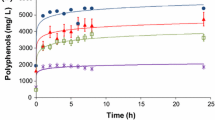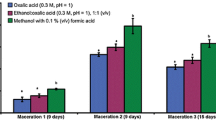Abstract
The incomplete anthocyanin extraction during the industrial processes turns grape pomace into an inexpensive source of phenolic compounds. The effects of temperature and enzyme preparation percentage (% E/S) on the anthocyanin recovery from grape pomaces of eight grape varieties were evaluated by their physicochemical characteristics and phenolic composition. A factorial 22 design with center point was used to select the preferred conditions for extraction, and the variables of temperature, enzyme preparation, and their interaction were assessed. The grape skin characteristics affected the anthocyanins’ content and their recovery yield, and different improvement conditions were found for each variety of grape. Anthocyanin extraction from Cabernet Sauvignon—the variety which showed the highest percentage of anthocyanin recovery (over 50%)—was improved. The lowest tested temperature (40 °C) and percentage of preparation enzymatic (0.25% E/S) promoted higher anthocyanin extraction, resulting in a natural food colorant with 2.67 g anthocyanins/100 g grape skin dry basis (db). The extraction improvement allowed for a non-toxic natural extract rich in anthocyanins to be obtained; a natural additive which can be considered for potential food industry use in place of synthetic dyes, especially into acidic matrices.




Similar content being viewed by others
References
AOAC 950.46 (2000) Official methods of analysis, 18th edn. Maryland
Baiano A (2014) Recovery of biomolecules from food wastes - a review. Molecules 19:14821–14842
Bautista-Ortín AB, Busse-Valverde N, Fernández-Fernández JI, Gómez-Plaza E, Gil-Muñoz R (2016) The extraction kinetics of anthocyanins and proanthocyanidins from grape to wine in three different varieties. J Int des Sci la Vigne du Vin 50:91–100. https://doi.org/10.20870/oeno-one.2016.50.2.781
Boulton R (2001) The copigmentation of anthocyanins and its role in the color of red wine: a critical review. Am J Enol Vitic 52:67–87. https://doi.org/10.1063/1.337514
Castellar MR, Obón JM, Fernández-López JA (2006) The isolation and properties of a concentrated red-purple betacyanin food colourant from Opuntia stricta fruits. J Sci Food Agric 86:122–128. https://doi.org/10.1002/jsfa.2285
Chardonnet C, Donéche B (2015) Relation entre la teneur en calcium et la resistance à la digestion enzymatique du tissu pelliculaire au cours de la maturation du raisin. VITIS - J Grapevine Res 34:95
Cliff MA, King MC, Schlosser J (2007) Anthocyanin, phenolic composition, colour measurement and sensory analysis of BC commercial red wines. Food Res Int 40:92–100. https://doi.org/10.1016/j.foodres.2006.08.002
Cortez R, Luna-Vital DA, Margulis D, Gonzalez de Mejia E (2017) Natural pigments: stabilization methods of anthocyanins for food applications. Compr Rev Food Sci Food Saf 16:180–198. https://doi.org/10.1111/1541-4337.12244
Dal Magro L, Goetze D, Ribeiro CT, Paludo N, Rodrigues E, Hertz PF, Klein MP, Rodrigues RC (2016) Identification of bioactive compounds from Vitis labrusca L. variety concord grape juice treated with commercial enzymes: improved yield and quality parameters. Food Bioprocess Technol 9:365–377. https://doi.org/10.1007/s11947-015-1634-5
Delgado-Vargas F, Jiménez AR, Paredes-López O, Francis FJ (2000) Natural pigments: carotenoids, anthocyanins, and betalains - characteristics, biosynthesis, processing, and stability. Crit Rev Food Sci Nutr 40:173–289. https://doi.org/10.1080/10408690091189257
Deng Q, Penner MH, Zhao Y (2011) Chemical composition of dietary fiber and polyphenols of five different varieties of wine grape pomace skins. Food Res Int 44:2712–2720. https://doi.org/10.1016/j.foodres.2011.05.026
Dimitrovska M, Bocevska M, Dimitrovski D, Murkovic M (2011) Anthocyanin composition of Vranec, Cabernet Sauvignon, Merlot and Pinot Noir grapes as indicator of their varietal differentiation. Eur Food Res Technol 232:591–600. https://doi.org/10.1007/s00217-011-1425-9
FDA (2018) CFR- Code of Federal Regulations Title 21. In: Electron. Code Fed. Regul. https://www.ecfr.gov/cgi-bin/text-idx?SID=af797b59cea882f3016b51e587149a8a&mc=true&node=se21.1.73_1170&rgn=div8. Accessed 26 Nov 2018
Fernández K, Vega M, Aspé E (2015) An enzymatic extraction of proanthocyanidins from País grape seeds and skins. Food Chem 168:7–13. https://doi.org/10.1016/j.foodchem.2014.07.021
Fontana AR, Antoniolli A, Bottini R (2013) Grape pomace as a sustainable source of bioactive compounds: extraction, characterization, and biotechnological applications of phenolics. J Agric Food Chem 61:8987–9003. https://doi.org/10.1021/jf402586f
Gauche C, Malagoli E d S, Bordignon Luiz MT (2010) Effect of pH on the copigmentation of anthocyanins from Cabernet Sauvignon grape extracts with organic acids. Sci Agric 67:41–46. https://doi.org/10.1590/S0103-90162010000100006
Gervais J-P, Guerrand D (2001) Impact d’une nouvelle préparation de pectinases sur l’extraction des composés intra-cellulaires au cours de la macération des raisins rouges. Rev Fr Oenol 190:12–15
Giusti MM, Wrolstad RE (2001) Characterization and measurement of anthocyanins by UV-visible spectroscopy. Curr Protoc Food Anal Chem 1:1–13. https://doi.org/10.1002/0471142913.faf0102s00
González-Centeno MR, Rosselló C, Simal S, Garau MC, López F, Femenia A (2010) Physico-chemical properties of cell wall materials obtained from ten grape varieties and their byproducts: grape pomaces and stems. LWT Food Sci Technol 43:1580–1586. https://doi.org/10.1016/j.lwt.2010.06.024
Goula AM, Thymiatis K, Kaderides K (2016) Valorization of grape pomace: drying behavior and ultrasound extraction of phenolics. Food Bioprod Process 100:132–144. https://doi.org/10.1016/j.fbp.2016.06.016
Hanlin RL, Kelm M, Wilkinson KL, Downey MO (2011) Detailed characterization of proanthocyanidins in skin, seeds, and wine of Shiraz and Cabernet Sauvignon wine grapes (Vitis vinifera). J Agric Food Chem 59:13265–13276. https://doi.org/10.1021/jf203466u
He J, Giusti MM (2010) Anthocyanins: natural colorants with health-promoting properties. Annu Rev Food Sci Technol 1:163–187. https://doi.org/10.1146/annurev.food.080708.100754
Jordão AM, Correia AC, Gonçalves FJ (2012) Evolution of antioxidant capacity in seeds and skins during grape maturation and their association with proanthocyanidin and anthocyanin content. Vitis - J Grapevine Res 51:137–139
Konczak I, Zhang W (2004) Anthocyanins - more than nature’s colours. J Biomed Biotechnol 12:239–240. https://doi.org/10.1155/S1110724304407013
Koshita Y, Yamane T, Yakushiji H, Azuma A, Mitani N (2011) Regulation of skin color in “Aki Queen” grapes: interactive effects of temperature, girdling, and leaf shading treatments on coloration and total soluble solids. Sci Hortic (Amsterdam) 129:98–101. https://doi.org/10.1016/j.scienta.2011.03.014
Ky I, Teissedre PL (2015) Characterisation of Mediterranean grape pomace seed and skin extracts: polyphenolic content and antioxidant activity. Molecules 20:2190–2207. https://doi.org/10.3390/molecules20022190
Liang Z, Sang M, Fan P, Wu B, Wang L, Yang S, Li S (2011) CIELAB coordinates in response to berry skin anthocyanins and their composition in vitis. J Food Sci 76:490–497. https://doi.org/10.1111/j.1750-3841.2011.02095.x
Lima MDS, Silani IDSV, Toaldo IM et al (2014) Phenolic compounds, organic acids and antioxidant activity of grape juices produced from new Brazilian varieties planted in the Northeast Region of Brazil. Food Chem 161:94–103. https://doi.org/10.1016/j.foodchem.2014.03.109
Maier T, Göppert A, Kammerer DR, Schieber A, Carle R (2008) Optimization of a process for enzyme-assisted pigment extraction from grape (Vitis vinifera L.) pomace. Eur Food Res Technol 227:267–275. https://doi.org/10.1007/s00217-007-0720-y
Markakis P (1982) Anthocyanins as food colors. Academic Press, Cambridge
Martínez-Maqueda D, Hernández-Ledesma B, Amigo L, Miralles B, Gómez-Ruiz JÁ (2013) Extraction/fractionation techniques for proteins and peptides and protein digestion. In: Toldrá F, Nollet LML (eds) Proteomics in foods: principles and applications. Springer US, Boston, pp 21–50
McCann D, Barrett A, Cooper A, Crumpler D, Dalen L, Grimshaw K, Kitchin E, Lok K, Porteous L, Prince E, Sonuga-Barke E, Warner JO, Stevenson J (2007) Food additives and hyperactive behaviour in 3-year-old and 8/9-year-old children in the community: a randomised, double-blinded, placebo-controlled trial. Lancet 370:1560–1567. https://doi.org/10.1016/S0140-6736(07)61306-3
Moreno-Pérez A, Fernández-Fernández JI, Bautista-Ortín AB, Gómez-Plaza E, Martínez-Cutillas A, Gil-Muñoz R (2013) Influence of winemaking techniques on proanthocyanidin extraction in Monastrell wines from four different areas. Eur Food Res Technol 236:473–481. https://doi.org/10.1007/s00217-012-1899-0
OIV (2018) OIV Statistical Report on World Vitiviniculture. International Organisation of Vine and Wine. http://www.oiv.int/public/medias/6371/oivstatistical-report-on-world-vitiviniculture-2018.pdf. Accessed 15 June 2018
Pinelo M, Arnous A, Meyer AS (2006) Upgrading of grape skins: significance of plant cell-wall structural components and extraction techniques for phenol release. Trends Food Sci Technol 17:579–590. https://doi.org/10.1016/j.tifs.2006.05.003
Pomar F, Novo M, Masa A (2005) Varietal differences among the anthocyanin profiles of 50 red table grape cultivars studied by high performance liquid chromatography. J Chromatogr A 1094:34–41. https://doi.org/10.1016/j.chroma.2005.07.096
Proestos C, Komaitis M (2008) Application of microwave-assisted extraction to the fast extraction of plant phenolic compounds. LWT Food Sci Technol 41:652–659. https://doi.org/10.1016/j.lwt.2007.04.013
Rapisarda P, Tomaino A, Lo Cascio R, Bonina F, de Pasquale A, Saija A (1999) Antioxidant effectiveness as influenced by phenolic content of fresh orange juices. J Agric Food Chem 47:4718–4723. https://doi.org/10.1021/jf990111l
Ribeiro LF, Ribani RH, Francisco TMG, Soares AA, Pontarolo R, Haminiuk CWI (2015) Profile of bioactive compounds from grape pomace (Vitis vinifera and Vitis labrusca) by spectrophotometric, chromatographic and spectral analyses. J Chromatogr B 1007:72–80. https://doi.org/10.1016/j.jchromb.2015.11.005
Sommella E, Pepe G, Pagano F, Conte G, Carimi F, Tenore GC, Novellino E, Manfra M, Russo M, Campiglia P (2016) Rapid screening of antioxidant anthocyanins in autochthonous Nero d’Avola grape clones by pre-column DPPH reaction coupled to UHPLC-UV/Vis-IT-TOF: a strategy to combine chemical data and genetic diversity. Food Anal Methods 9(10):2780–2790. https://doi.org/10.1007/s12161-016-0472-z
Stoll L, Costa TMH, Jablonski A, Flôres SH, de Oliveira Rios A (2016) Microencapsulation of anthocyanins with different wall materials and its application in active biodegradable films. Food Bioprocess Technol 9:172–181. https://doi.org/10.1007/s11947-015-1610-0
Tanaka Y, Sasaki N, Ohmiya A (2014) Biosynthesis of plant pigments: anthocyanins, betalains and carotenoids. Plant J 54:733–749. https://doi.org/10.1111/j.1365-313X.2008.03447.x
Walker TL, Morris JR, Threlfall RT, Main GL, Lamikanra O, Leong S (2001) Density separation, storage, shelf life, and sensory evaluation of ‘Fry’ muscadine grapes. HortScience 36:941–945
Wang L, Weller CL (2006) Recent advances in extraction of nutraceuticals from plants. Trends Food Sci Technol 17:300–312. https://doi.org/10.1016/j.tifs.2005.12.004
Yu J, Ahmedna M (2013) Functional components of grape pomace: their composition, biological properties and potential applications. Int J Food Sci Technol 48:221–237. https://doi.org/10.1111/j.1365-2621.2012.03197.x
Zanatta CF, Cuevas E, Bobbio FO, Winterhalter P, Mercadante AZ (2005) Determination of anthocyanins from camu-camu (Myrciaria dubia) by HPLC−PDA, HPLC−MS, and NMR. J Agric Food Chem 53:9531–9535
Acknowledgments
The authors are grateful to Universidade Federal do Rio Grande do Sul (UFRGS) for technical assistance. We thank San Giovanni Winery, Pinheiral Winery, agroindustry Sbardelotto, and Buono Winery (winery and juice industries from Brazil) for providing grape pomaces.
Funding
Financial support was provided by CAPES and CNPq for this research.
Author information
Authors and Affiliations
Corresponding author
Ethics declarations
Conflict of Interest
Maria Jara Montibeller declares that she has no conflict of interest. Patric de Lima Monteiro declares that he has no conflict of interest. Liana Stoll declares that she has no conflict of interest. Diego Santiago Tupuna-Yerovi declares that he has no conflict of interest. Eliseu Rodrigues declares that he has no conflict of interest. Rafael Costa Rodrigues declares that he has no conflict of interest. Alessandro de Oliveira Rios declares that he has no conflict of interest. Vitor Manfroi declares that he has no conflict of interest.
Informed Consent
Informed consent was obtained from all individual participants included in the study.
Ethical Approval
This article does not contain any studies with human participants or animals performed by any of the authors.
Additional information
Publisher’s Note
Springer Nature remains neutral with regard to jurisdictional claims in published maps and institutional affiliations.
Electronic Supplementary Material
ESM 1
(DOC 45 kb)
Rights and permissions
About this article
Cite this article
Montibeller, M.J., de Lima Monteiro, P., Stoll, L. et al. Improvement of Enzymatic Assisted Extraction Conditions on Anthocyanin Recovery from Different Varieties of V. vinifera and V. labrusca Grape Pomaces. Food Anal. Methods 12, 2056–2068 (2019). https://doi.org/10.1007/s12161-019-01548-x
Received:
Accepted:
Published:
Issue Date:
DOI: https://doi.org/10.1007/s12161-019-01548-x




